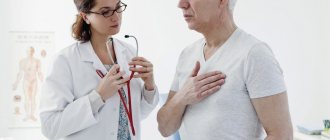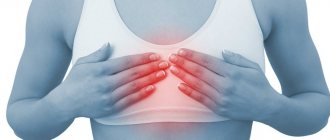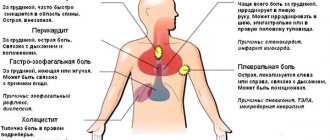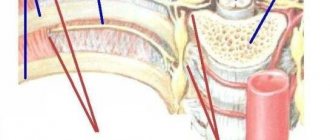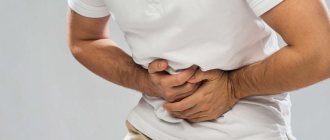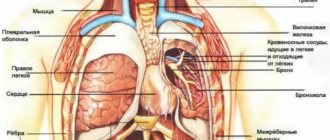Any pain indicates any pathologies that develop in the human body under the influence of certain factors. As practice shows, pain indicates disorders in the spine and its structures, as well as in internal organs. To identify pathology, you should immediately consult a doctor and undergo a full examination.
Symptoms
According to official data, pathologies of the spinal column are in second place in terms of prevalence. The spine is located in the middle of the back and is the support for the entire body. The middle part is connected to the ribs, and due to their anatomical structure, all internal organs and the spinal column itself influence each other.
Sometimes it is difficult for a specialist to determine an accurate diagnosis for pain in the chest and back, since it is difficult for the patient to understand the location of the discomfort.
The chest area is a component of the torso, and it contains quite important organs - the cardiovascular, respiratory, and digestive systems. Therefore, back pain in the thoracic region may indicate pathology in these organs.
In addition to pain, there are a number of other symptoms. Particular attention should be paid to the condition of the body as a whole and urgently consult a specialist in cases where the pain is acute or prolonged.
In addition to pain in the sternum, radiating to the back, there is a burning sensation in the chest area, numbness of the arms, dizziness and nausea. Many complain of shortness of breath and a feeling of tightness. In such cases, you need to call emergency help.
Causes of pain in the sternum radiating to the back
Back pain in the thoracic region is not always caused by pathology of the spine or heart, as many believe. Often the causes are injuries, diseases of the bronchopulmonary region, digestive tract, and neurological pathologies. A correct diagnosis will help to make not only a thorough examination, but also an initial history taking.
Treatment of chest pain
First of all, a diagnosis is carried out to identify the root cause of chest pain. If spinal pathology is detected, radiography or MRI examination is most often prescribed. If joints are affected, ultrasound and also MRI of the joint are prescribed. A joint puncture may be necessary.
Treatment includes taking medications that relieve pain, inflammation, muscle spasms, and restore pinched nerves. Physiotherapy and physical therapy are also prescribed, which improve blood circulation, metabolic processes, and strengthen the muscles of the back and chest.
Diseases of the musculoskeletal system
Due to age-related changes in the musculoskeletal system, diseases develop, which are often accompanied by pain in the back and chest. The most common of them are:
- chondrosis, osteochondrosis;
- spondyloarthrosis;
- types of intervertebral hernia.
It was noted that previously such pathologies in the thoracic region were not as common as they are now. This is associated with the recent low physical activity of the population. The back hurts, accompanied by chest pain, due to compression of the nerve endings that are located in the spinal part. Sometimes pain in the sternum and back is not particularly strong during the initial stages of osteochondrosis, and then, as the disease develops, they become significant. A herniated disc is characterized by a protrusion of the intervertebral disc. This compresses the spinal roots and blood vessels, which causes dull pain. It intensifies with exercise and goes away while lying down and resting. As the disease progresses, that is, with significant protrusion of the disc, chest pain becomes stronger and radiates to the back. Factors leading to the appearance of pathology can be injuries, excess weight, and improper lifting of heavy objects. Spondyloarthrosis develops in older people. In young people it occurs due to injuries and regular overload. This disease is characterized by damage to the facet joints, ligaments and periarticular muscles. A dull pain in the sternum appears with sudden movements, but goes away with rest. Patients experience stiffness in movement in the morning.
Principles of treatment
Pain relief is aimed at reducing pain and eliminating muscle spasms in the affected area. If taking NSAIDs orally or by injection does not help, blockades are performed. This is the introduction of drugs into the most painful points, which are projections of the exit of nerves. Local anesthetics, hormones, NSAIDs, and muscle relaxants are used. Diuretics reduce swelling of the compressed nerve and eliminate pain. Drugs are prescribed that improve the conductivity of nerve tissue.
In addition to relieving acute pain, it is necessary to influence the cause of pinching of the intercostal nerve in the thoracic region. Medicines, massages, manual therapy, physiotherapeutic procedures, reflexology, and physical therapy help reduce the destruction of bones and joints. Medicines prescribed:
- vascular drugs - improve blood circulation;
- chondroprotectors – restore the properties of the cartilage layer between the vertebrae;
- calcium supplements, vitamin D fight osteoporosis;
- multivitamin complexes with minerals.
Acupressure, lymphatic drainage and classic types of massage are used. The impact on the back muscles helps eliminate spasms, improves blood flow and tissue nutrition. Thanks to this, it is possible to break the pathological circle, when pain causes muscle contraction, which compresses nerve fibers and blood vessels, disrupting blood supply and increasing pain.
In some cases, surgical treatments may even be necessary. For example, to eliminate the consequences of an injury, remove a significant hernia, tumor, or perform spinal stabilization.
Every person should be attentive to their health and not ignore the symptoms of a pinched nerve in the thoracic region if they appear. It is important to seek qualified help immediately. After all, the earlier the problem is identified, the greater the chances of achieving complete restoration of the function of the nerves and all structures of the spinal column, and of avoiding another pinching under the breast in the future.
Neurological diseases
The most common neurological pathology is thoracic neuralgia. This disease is very common in elderly and middle-aged people. It is accompanied by severe pain, since the intercostal nerves are pinched. The reasons for the development of this disease can be:
- osteochondrosis;
- intervertebral hernia;
- inflammatory processes in tissues;
- injuries;
- malignant and benign tumors;
- significant load on the spine;
- congenital pathologies;
- stress;
- hormonal imbalance.
In addition, extra pounds, a passive lifestyle, constant overwork, and poor posture can often be the causes. The main thing that patients often complain about is chest and back pain. It is felt at the pinched site and may be aching or burning. At the same time, it intensifies with movements and sharp turns of the body. Since the intercostal nerves extend to many internal organs, innervating them, the pain radiates to the area of the heart, stomach, and scapula. Another important symptom is stiffness in the chest area. Some of the patients complain of irregular heart rhythm, breathing problems and increased blood pressure.
Classification
Depending on the source of pain in the thoracic spine, doctors distinguish:
- radicular pain - occurs due to compression of the spinal nerves due to diseases of the spine;
- referred - the pain is only localized in the spine, but the source is other organs;
- specific - characteristic of oncology, tuberculosis and other serious diseases;
- nonspecific - most often occurs due to curvature of the spine, often accompanied by radicular syndrome.
Back and chest injuries
With many types of injuries, the back and chest hurt, this often indicates a bruise, fracture of the ribs and vertebrae, as well as the sternum, which is less common. Similar injuries occur at work, accidents, or during sports activities. In this case, mild spinal injuries cause pain of moderate intensity and spread to nearby organs and tissues, including the chest and back. In more severe cases, injuries are accompanied by loss of sensation, especially in the hands, and hypotonicity is observed in the muscle tissue. Sometimes paralysis occurs, so it is important to call an ambulance immediately after the accident, and until doctors arrive, do not touch the victim, trying to change his body position. A fracture of the sternum bone is a very rare type of injury, most often it occurs during accidents, less often during martial arts. The bone breaks when hitting the steering wheel or being impacted by a seat belt. In case of injury, the following symptoms appear:
- pain in the middle of the chest and back, which increases with deep breathing;
- swelling and hematomas;
- visible deformation in the chest area due to displacement of bone fragments.
As a rule, the body immediately reacts to mechanical damage with a variety of symptoms that require an immediate visit to the doctor.
Prevention
To ensure that chest and back pain bother you as little as possible, you must follow some rules of a healthy lifestyle:
- You need to walk and sit correctly; to do this, try to slouch less.
- Avoid lifting objects that are too heavy. Neglecting this point may result in injury and pain. If you still need to lift something, you must first bend your knees so as not to create unnecessary stress on the spinal column.
- If possible, limit your body position to a sitting position. If you work at a computer, you need to get up and stretch your muscles as often as possible. It is better for drivers to periodically stop the car and go for a walk.
- Limit consumption of salt, sweets, fatty and spicy foods. It is recommended to eat foods rich in vitamins and minerals.
- Develop healthy habits: exercise, sleep at least 6-8 hours at night, eat right. A healthy lifestyle will help you feel a surge of strength and energy, and also relieve pain.
It is worth limiting, or better yet completely eliminating, drinking alcohol and smoking. After all, toxic substances lead to degeneration of all tissues, even bone. After scientific research, it was found that alcohol-containing drinks have the ability to wash out all trace elements from bones.
Referred pain
Referred pains are those that do not occur in the area of the diseased organ, but appear elsewhere. This often leads to misdiagnosis. Such pathologies include the following:
- bronchitis and pneumonia – pain in the front of the chest and back;
- a hypertensive crisis may be accompanied by pain near the shoulder blades;
- myocarditis and pericarditis – pain in the middle of the chest;
- myocardial infarction - burning pain in the sternum, back, as well as in the shoulder blade, arm, and shoulder on the left;
- angina pectoris - short-term chest pain, lasts no more than 10-20 minutes, radiates to the left shoulder and arm;
- ulcer of the stomach and duodenum - a sharp or aching pain that starts from the stomach and radiates to the chest and left arm;
- pancreatitis - the pain is girdling in nature and radiates to the hypochondrium.
Sometimes pain can radiate to the chest area and back with kidney disease and cholelithiasis.
Diagnosis of chest pain
If a person complains of pain in the thoracic region, the neurologist will immediately diagnose thoracalgia syndrome and begin a targeted diagnosis of the pathology that can give rise to these painful sensations. To do this, a differential diagnosis is carried out, during which the doctor excludes diseases such as:
- cardiac problems using an ECG study, if the patient has pain in the left thoracic region;
- lung diseases using fluorography, if the patient has a cough and sharp pain in the thoracic spine;
- pathologies of the esophagus and stomach using endoscopy, when the patient complains of pain in the thoracic region and stomach or acute pain in the cervicothoracic region.
In order to exclude serious abnormalities of the spine, for example: hernia, compression fractures of the vertebrae, tumor or tuberculosis of the spine, the neurologist will refer the patient for an MRI of the thoracic spine.
| Service | Price | Price | Promotion Price |
| Appointment with a therapist | primary 1800 rub. | repeat 1500 rub. | |
| Neurologist appointment | primary 1800 rub. | repeat 1500 rub. | free after MRI of the spine |
| Orthopedist appointment | primary 1800 rub. | repeat 1500 rub. | free after MRI of the joint |
| Consultation with an acupuncturist | primary 1800 rub. | repeat 1500 rub. | free after MRI of the spine |
| Vertebrologist consultation | primary 2000 rub. | repeat 1800 rub. | |
| Consultation with a chiropractor/osteopath | primary 2500 rub. |
| Service | Price according to Price | Discount | Discount |
| Plasma therapy of the spine or joint | 1 session 4000 rub. free doctor's appointment | 3 sessions 10,500 rub. free doctor's appointment | 5 sessions 17,500 rub. free doctor's appointment |
| Classic acupuncture session | 1500 rub. | ||
| Complex acupuncture session | 2000 rub. | ||
| Manual osteopathy session | 2500 rub. | ||
| Manual therapy session | 2500 rub. | ||
| Autohemotherapy | 550 rub. | 5 sessions 2500 rub. | 10 sessions 5000 rub. |
| Novocaine therapeutic blockade | 1500 rub. | ||
| Therapeutic paravertebral blockade | 1500 rub. | ||
| The blockade is therapeutic and medicinal, complex (use of several drugs) | 2000 rub. | ||
| Therapeutic intra-articular blockade with diprospan | 2500 rub. | ||
| Joint puncture with removal of synovial fluid | 2500 rub. | ||
| Intra-articular injection of hyaluronic acid (without the cost of the drug) | 2000 rub. | ||
| Novocaine therapeutic blockade | 1500 rub. | ||
| Therapeutic paravertebral blockade | 1500 rub. | ||
| Therapeutic intra-articular blockade with diprospan | 2500 rub. | ||
| Joint puncture with removal of synovial fluid | 2500 rub. | ||
| Pharmacopuncture session (drug at the discretion of the doctor) | 2500 rub. | ||
| Pharmacopuncture session (without the cost of the drug) | 2100 rub. | ||
| Electrophoresis session (without the cost of the drug) | 400 rub. | ||
| Phonophoresis session / Ultrasound therapy procedure (UT) (without the cost of the drug) | 450 rub. | ||
| Magnetic therapy session | 350 rub. | ||
| SMT therapy session (Sinusoidal modulated currents) | 450 rub. | ||
| Vitamin therapy (10 injections) | 4000 rub. free doctor's appointment | 3000 rub. free doctor's appointment | 3000 rub. free doctor's appointment |
| Injections (Vitamins B12) | 800 rub. | 800 rub. | 800 rub. |
| Intravenous administration of drugs | 450 rub. | 5 sessions 2140 rub. | 10 sessions 4050 rub. |
| Intravenous drip administration of drugs (without drugs, 1 bottle) | 800 rub. | 5 sessions 3375 rub. | 10 sessions 6750 rub. |
| Intravenous drip administration of medications (with existing clinic medications, 1 bottle) | 950 rub. | 5 sessions 4050 rub. | 10 sessions 8100 rub. |
| Intravenous drip administration of drugs (without drugs, 2 bottles) | 950 rub. | 5 sessions 4050 rub. | 10 sessions 8100 rub. |
| Intravenous drip administration of medications (with existing clinic medications, 2 bottles) | 1100 rub. | 5 sessions 4700 rub. | 10 sessions 9400 rub. |
| Subcutaneous/intradermal administration of drugs | 250 rub. | 5 sessions 1180 rub. | 10 sessions 2250 rub. |
| Intramuscular administration of drugs | 300 rub. | 5 sessions 1430 rub. | 10 sessions 2700 rub. |
Preventive measures for back and chest pain
To prevent back and chest pain, you will need to follow some rules and make some lifestyle changes. The most important measures are:
- correct diet in compliance with BJU and calorie content;
- drinking regime;
- night rest on a flat mattress and anatomical pillow;
- taking vitamin complexes;
- moderate exercise daily;
- active lifestyle (running, swimming, Nordic walking, walks in the fresh air);
- correct posture while walking and working at a desk;
- proper weight lifting;
- comfortable shoes.
Preventive visits to doctors and periodic examinations are also important. In addition, you need the right psychological attitude and positive thinking. By changing your lifestyle, you can reduce the likelihood of developing diseases, including preventing pain in the sternum and back.
